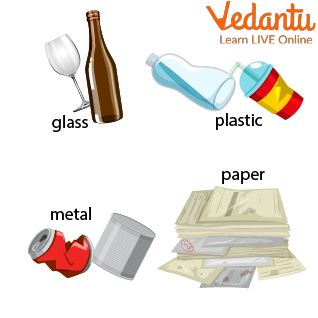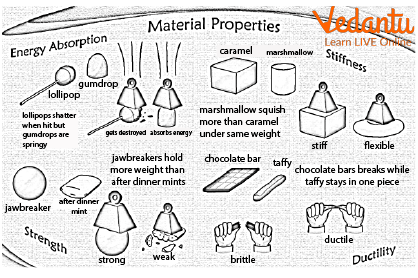




Why Understanding Materials Matters in Everyday Life
There are many types of materials that are most commonly used in daily life. The knowledge of different types of materials allows for the comparison of everyday materials, for example, different types of wood, rock, metal, paper, and plastic, according to their properties.
The properties of material include hardness, strength, flexibility and magnetic behaviour. Different types of material and their properties can be used in the making of many different objects which can be used in day-to-day life. For instance, the hardness of iron, ductility of gold, and silver, the conductivity of copper etc. Let us learn more about such materials and their properties ahead.
Different Types of Materials
Biomaterials
A biomaterial is any substance that can be engineered for interaction with biological systems for a medical purpose. For example, they are used for therapeutic purposes, i.e. to treat, augment, repair or replace a tissue function of the body or a diagnostic one. The study of biomaterials is known as biomaterials science or biomaterials engineering. Biomaterials science encompasses the elements of medicine, biology, chemistry, tissue engineering and materials science.
Ceramics
Ceramic is a non-metallic material made up of inorganic molecules. The ceramic is normally prepared by heating a powder or slurry. So many common ceramics are made up of oxides or nitride compounds, high in a crystalline form with long-range molecular order. The ceramics are halfway or fully amorphous and with no long-range molecular order. These are typically classified into glassy materials.
Metals
The metals are malleable comparatively. The metals are optically reflective and electrically conductive. Mostly the metals and alloys can be easily shaped by forming. The metals disassociate electron bonding and make them good conductors of electricity and heat. Each metal has an orderly arrangement of atoms, resulting in a crystalline structure that may have multiple crystal phases bordering each other.
Nanomaterials
The nanomaterial is defined as the material with any external dimension in the nanoscale or having an internal structure or surface structure in the nanoscale. The nanoscale is defined as the length range, approximately from 1 nm to 100 nm. This includes both nano-objects and nanostructured materials.
The nanomaterials are discrete pieces of material, and the nanostructured material has an internal or surface structure on the nanoscale. The nanomaterial can be a member of both these categories.
Wood
Wood is called a composite material. It is made from lignin and cellulose. It uses a lignin matrix and cellulose fibre to form a polymer composite. The lignin helps to hold the cellulose compressively in place so that the cellulose fibre can carry the tensile loads. Wood has excellent structural properties in light of its low weight and high strength.

Different Types of Materials
Different Types of Materials and Their Properties
Materials can also be explained based on their properties. It is important to understand the material's properties to decide whether the material is suitable for its use. When we talk about a material's properties, we mention the features we can sense, measure or test. For example, if we have any kind of sample of metal in front of us, we can identify what the colour of that material is, whether it is hard or shiny.
Testing the materials shows that they can conduct heat and electricity and that they will react with an acid. These are some properties of metals, which enable us to identify them.

Image Showing Properties of Different Materials
Physical and Chemical Properties
Almost all materials contain physical properties. A physical property is a property that a person can measure without changing the material. Examples of physical properties are colour, amount, hardness, and temperature.
Similarly, materials also have chemical properties. A chemical property tells us how a material will change into a different substance under specific conditions. For example, some metals rust if they are kept out in the rain. Paper and wood burn to ashes if they come in contact with the flame.
Summary
Any type of substance used to make something is known as material. For example, the school desk can be prepared from wood, plastic, or metal or a mixture of all three materials. When any kind of object is designed and made, it is very important to choose the best material for the job. Materials have certain qualities or properties. For example, the properties of materials include strength, colour, and hardness, which must be considered carefully. Some other factors, such as cost and availability, are also important.
FAQs on Different Types of Materials and Their Properties
1. What are materials, and how are they generally classified?
A material is any substance or mixture of substances that constitutes an object. Materials can be pure or impure, living or non-living. They are primarily classified based on their origin into two main groups: Natural Materials (found in nature, like wood, cotton, and rock) and Man-made Materials (synthesised by humans, like plastic, nylon, and glass).
2. What are the common physical properties used to describe and group materials?
Materials are grouped based on their distinct physical properties. Some of the most common properties studied are:
Appearance: Whether the material is shiny (lustrous) or dull.
Hardness: The material's resistance to being scratched or compressed.
Transparency: How much light can pass through the material (transparent, translucent, or opaque).
Solubility: Whether the material dissolves in a liquid like water.
State: Whether it is a solid, liquid, or gas at room temperature.
Conductivity: Its ability to conduct heat or electricity.
3. How can we group materials based on their appearance?
Materials can be grouped based on their surface shine, a property known as lustre. Materials that have a natural shine, like gold, silver, and freshly cut iron, are called lustrous materials. Those that have no shine and appear dull, such as wood, chalk, and cotton, are called non-lustrous materials. This property is often used to distinguish metals from non-metals.
4. What is the difference between transparent, translucent, and opaque materials?
This classification is based on how much light can pass through a material.
Transparent materials allow light to pass through them completely, so we can see clearly through them. Examples include glass and clean water.
Translucent materials allow only some light to pass through, making objects on the other side appear blurry. Examples include frosted glass and butter paper.
Opaque materials do not allow any light to pass through them at all. Examples include wood, stone, and metal.
5. What does the property of solubility tell us about a material?
Solubility is the ability of a material (solute) to dissolve in a liquid (solvent). If a substance completely disappears in water, it is called soluble in water (e.g., salt, sugar). If it does not dissolve and remains separate, it is called insoluble in water (e.g., sand, chalk powder). This property is crucial in many applications, such as making drinks or separating mixtures.
6. Can you give examples of materials derived from living and non-living sources?
Yes, materials can be sourced from both living and non-living things.
Materials from living sources (plants and animals) include wood, paper, and cardboard from trees; cotton from cotton plants; wool from sheep; and leather from animal skin.
Materials from non-living sources include metals and gems mined from rocks; clay and sand from the earth; and plastics, which are derived from petroleum.
7. Why is it important to choose the right material for making a specific object?
Choosing the right material is crucial because an object's function depends directly on its material's properties. For example, a cooking pan must be made of a metal (a good conductor of heat) to cook food efficiently, but its handle should be made of plastic or wood (poor conductors) to prevent burns. Similarly, a window is made of glass (transparent) to let in light, not wood (opaque). Selecting the wrong material would make the object useless or unsafe.
8. How does the property of hardness determine the use of a material in everyday life?
Hardness, which is the ability to resist scratching and wear, is a critical factor in determining a material's use. Very hard materials like diamond are used in cutting tools. Building materials such as stone and steel must be hard to provide strength and durability to structures. In contrast, soft materials like cotton and rubber are used for comfort in clothing or for flexibility in tyres, where hardness is not a desired property.
9. Why do some materials like wood float on water while a stone sinks?
Whether an object floats or sinks depends on its density compared to the density of water. Density is the mass of the material packed into a certain volume. Materials like wood and some plastics are less dense than water, which allows them to float. On the other hand, materials like stone and iron are more dense than water. Their weight is greater than the buoyant force of the water, causing them to sink.
10. Besides physical properties, what other factors are important when selecting a material?
While physical properties like strength and hardness are primary, several other factors influence material selection. These include the cost of the material, its availability, its environmental impact (is it recyclable or biodegradable?), and its workability (how easily it can be shaped into the desired object). For large-scale manufacturing, these factors are just as important as the material's scientific properties.





















